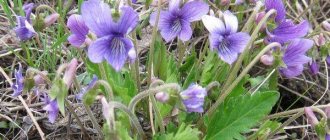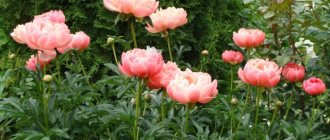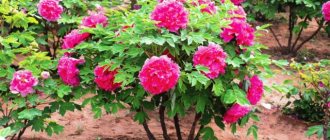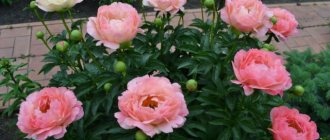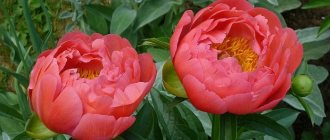Mountain or spring peony is a rare species in the wild, found only in the southern part of Primorye, East Asia and some islands of Japan. Recently it has been classified as an endangered species.
It is a perennial plant that has excellent frost resistance, which is why it is able to survive the winter. Based on territorial preferences, it can exist in forests with mixed vegetation.
Prefers to grow in the shade, in particular on the slopes of hills or near rivers. Such a flower is not prone to forming large clusters, which is why it is possible to encounter a clearing dotted with peony only in isolated cases. Almost always grows singly or in small groups.
Description
Thin-leaved peony or angustifolia peony has interesting leaves, the color of which is very juicy and even after the end of flowering in bright, usually red shades of flowers, it continues to delight the eye with its spectacular appearance.
The bush itself is small, regularly rounded, only about 50 cm high. At the end of May, more than a dozen fragrant flowers bloom for a period of 4-10 days. During this period of time, we see stunningly beautiful blooms. Flowers with a diameter of 8-10 cm have 5 petals and many golden anthers.
In the middle of summer, the fruits grow, they contain black-brown seeds of the plant, hence another, unofficial name of the Thin-leaved Peony - Voronets. In August, the tops of the plant die and only the rhizomes remain.
Over time, the bush grows in volume and begins to bloom quite extensively, and flowering continues for about 15 years in a row. It should be noted that this unpretentious plant can withstand both light frosts and drought, but for all its unpretentiousness it is listed in the Red Book.
Is it possible to grow mountain peonies at home?
Mountain peonies propagated vegetatively can theoretically grow in private gardens. But in practice this happens quite rarely. Basically, to increase their numbers, they are grown in botanical gardens, using a scientific approach to this work. In suitable conditions, the mountain peony takes root and blooms.
Attention! Plants grown under artificial conditions are slightly different in appearance from wild ones: their leaves and flowers are larger, and their roots are more powerful. Sometimes they bloom earlier than in nature: in mid-April, and not as expected in May.
Choosing a landing site
If several conditions are met, even an inexperienced gardener will be able to not only grow, but also maintain the life of the plant for a long time.
The soil should not be soggy so that the rhizomes do not rot. The exception is the period of bud formation; at this time the plant should be watered abundantly. It is important that the soil is not acidic; thin-leaved peony will not take root in such an environment. To do this, the soil must be alkalized with mineral fertilizers, or lime, or wood ash. A 10-15 cm layer of drainage, for example, small stones, gravel, broken bricks, should be placed in the hole of the planting pit. The thin-leaved peony loves moisture, but suffers and quickly dies from stagnation of moisture at the roots.
Peony thin-leaved should be planted in a well-lit area; it feels great in the shade, but it is still worth spending most of the time in the sun. The planting site should be protected from drafts and strong winds; the plant should not be planted in an open area, but perhaps in a corner of the garden. From an aesthetic point of view, when choosing a place for future planting of thin-leaved peony, it is worth observing the temporary characteristics of flowering. After all, in the middle of summer, the aesthetic appearance of the plant’s leaves will fade away, and perhaps it’s worth hiding it by planting it in flowerbeds behind or among lushly flowering fellow plants for the second half of summer and early autumn.
Limiting factors
The most common limiting factors are considered to be:
- people collecting flowers to form bouquets;
- extensive deforestation;
- frequent forest fires;
- digging up rhizomes - this is explained by the fact that such a plant has a large number of medicinal properties;
- economic development of germination areas.
To preserve the population, strictly protected natural reserves have been created - work is being carried out on them regarding a more detailed study of the species and the possibility of increasing its number.
Reproduction methods
Most often, thin-leaved peony is planted using bush propagation. To do this, I use mature bushes that are about 5 years old; this method is less time-consuming and labor-intensive and helps rejuvenate the plant.
This is usually done in the fall. The plant is divided into parts (divisions) with 2-3 buds, and planted in a hole measuring 60x80 cm, with nutritious soil previously poured into it; during this period, you can also change its place of growth. The bushes are planted at a distance of a little more than half a meter from each other, sprinkling the buds with soil so that there is about 5 cm of soil above the buds, and be sure to sprinkle the cut areas with wood ash to avoid rotting. To top it all off, you need to pour a small hill around the seedlings and fertilize them with humus or peat. But you should not compact the soil at the planting site; the fragile roots of the plant suffer greatly from this.
Another, but no less popular, planting method is sowing seeds. It is more labor-intensive and time-consuming, and the most unpleasant thing about this method is that there is a high probability that the sown seeds may not sprout.
The seed pods are collected in July, when they have not yet opened, wrapped in paper and hidden in the refrigerator until mid-autumn. Almost before winter they are sown in loosened soil, and the plant will sprout with the arrival of spring. But thin-leaved peony is rarely propagated in this way, mainly solely due to the fact that in this case, at least five, or even six years will pass before the first flowering.
There is also a rarer method of propagation - by root cuttings and is also performed in the fall, since at this time the roots of the plant are formed. Vertical root layers are planted at a distance of 60-70 cm.
Factors influencing numbers
Mountain peonies suffer greatly due to man's irrational attitude towards nature. We have already talked about the fact that people thoughtlessly pick flowers in the forests. But the plant is brought to the brink of survival not only by this factor. Amateur gardeners dig up rhizomes to grow a beautiful flower in their garden plots. The forests in which the mountain peony feels best are being cut down. Often this logging is illegal, poached, pursuing only personal gain. In this case, people do not think about the preservation of herbaceous vegetation at all.
Damage to the mountain peony population is caused by forest fires, which most often occur due to human negligence. In addition, a serious limiting factor is the agricultural development of territories, which increases the recreational load on the forest. This means that human influence can lead to both a slight change in the forest landscape and complete degradation of the ecosystem, which is a disaster for nature.
Beneficial features
Thin-leaved peony is considered poisonous because its roots contain neonin, but nevertheless it is widely used to treat a number of diseases. For a long time it has been used as an antispasmodic, diuretic, expectorant, bactericidal, protistocidal (antiparasitic) and sedative. It helps well with heart pain, kidney and bladder stones, concussions, nervous diseases, as well as in the treatment of anemia and gout. Pulmonary tuberculosis is treated with an infusion of peony rhizomes. Among other things, Peony contains in all its parts many other useful components for medicinal use, such as: tannins, anthocyanins, flavonoids, vitamin C and fatty oil.
This incomparable shrub is often decorated with all kinds of landscape designs. Peony will decorate any slides and rock gardens and gets along well with plants and shrubs in mixed borders. Often combined with other varieties of peonies, taking into account their flowering at different times, thin-leaved peonies are planted alone, which does not imply splendor.
The fine-leaved peony, with its showiness, will for a long time bring great aesthetic pleasure not only to the gardener, but also to his guests; the striking coloring of its flowers and unusual leaves will not leave anyone indifferent.
Source
Sectional classification
A more common classification of peonies was proposed by the biologist Kampularia-Natadze. Wild species according to this classification are divided into 5 sections:
- Moutan DC. These are shrubby species common in East Asia.
- Flavonia Kem. — Nat. The name of the section is translated as “Flavones of Campularia-Natadze”. Here are collected 8 species that have a coloring pigment - flavone, found within the Far East and the Caucasus. It is in this section that the mountain peony (a plant from the Red Book) is presented.
- Onaepia Lindley. Several herbaceous peonies with fleshy, cut leaves. Distributed in western North America. The section consists of two types.
- Paeon DC. An extensive section consisting of 26 varieties. Herbaceous plants with fleshy foliage, along the edges of which there are deep cuts. Distribution area: Caucasus, Asia, Europe, Far East, China, Japan.
- Sternia Ket.—Nath. There are 12 herbaceous species collected here, united by leaf shape. Their shape is three-triple with deep cuts or pinnately dissected with linear lobes.
Now, after general information about peonies and their classification, it’s time to talk in more detail about the endangered species - Mountain Peony. The Red Book (a description of the flower itself will be presented below) is updated almost every year with new species of flowers and plants that need special protection.
Peculiarities
It is impossible to give even the briefest description of the thin-leaved peony without mentioning its belonging to the Buttercup family. A characteristic feature of the plant is that it is covered with relatively narrow leaves of great length. Along with its attractive appearance, narrow-leaved peony has an extraordinary aroma. The narrow foliage is painted in bright green tones. Even in autumn they do not change to yellow for a long time.
The buds are medium in size - up to 0.1 m. They are characterized by a rich, bright red color. A large number of soft golden anthers also looks attractive.
The thin-leaved peony begins to bloom at the end of May. Flowering duration is 10 days, with more than 10 buds per bush.
The plant generally appears round and grows up to 0.5 m in height. By mid-June the buds have completely faded. In their place come fruits in the form of boxes. Inside are seeds colored black-brown. With the arrival of August, the top of the peony dries out, and after that only the rhizome can be found.
From year to year, narrow-leaved peonies grow more and more. The number of buds increases, and the flowers themselves increase in volume. The lifespan of the plant can reach 15 years.
Interesting fact: despite the ease of adaptation to weather conditions, the thin-leaved peony is included in the Red Book. Voronets and other species of this group can withstand minor frosts and summer drought, but they cannot withstand the interest of poachers.
Peony responds very poorly to excess moisture. When intensively watering, care should be taken to ensure that water does not accumulate at the root. Violation of this rule threatens the death of the plantings. Thin-leaved peonies are toxic, however, this does not prevent them from being used (only under the supervision of a doctor!) to combat:
The pharmaceutical industry has long appreciated the effects of this plant. Preparations prepared from it:
The decorative properties of the raven appear not only during the period when it blooms. Even when the buds fade, the original leaves remain attractive. During budding, the perennial crop is covered with blood-red or yellow buds with a purple tint. Their disclosure, with rare exceptions, occurs simultaneously. Therefore, the thin-leaved peony seems to take on a spherical shape.
The beauty of the leaves of this species is associated with the leaves of ferns. What is important in decorative terms is that the leaves appear to pubescent the bud and enhance its aesthetic properties.
The plant performs very well even in most of Siberia. Its main area of application is landscape design. With proper care, every bush will be attractive.
Wild peonies inhabit the southeast of the Russian Federation. You can find them in the Caucasian states, Asia Minor, and the Balkans. There the species inhabits forest edges and stone-covered slopes. Glades in the middle of the forest are also being reclaimed by peony. The shoots of wild plants come out as soon as the snow melts.
Sometimes the root is considered to resemble an oblong potato tuber. The fruits appear in July and August. By type they belong to the pubescent polyfolia. In addition to the main useful substances, peony includes:
Thin-leaved peony also turns out to be an excellent honey plant. You can safely buy store-bought seeds, even if they are wrinkled. But they should not be stored for a very long time. In this case, a lot of valuable moisture is lost.
It is much more correct to collect seed directly from plants.
What other types of herbaceous plants are peonies?
Three-triple peony (P. tritemata Pall ex de Candol)
It grows in the Crimea and the North Caucasus, in mountain deciduous forests on open slopes. Stems are 50-100 cm high, thin, often twisting. The flowers are purple.
Peony "Wittmann" (P. unttmanniana Hartwiss ex Lindl)
The species is distributed in European Russia, in Siberia, and is found in Kazakhstan, Mongolia and China. In the north - in the Komi Republic.
Endemic, grows in Abkhazia, in forests and on the edges of mountainous areas. Stems 80-100 cm high. Leaves are dark green. The flowers are wide open, pale yellow, later cream. One of the early flowering species.
Peony evasive (P. anomala L.), commonly known as Maryin root.
Grows in forests, forest edges and meadows. The bush is elegant. Stems are single-flowered, 80-100 cm high, red-colored. The leaves are double-triple, with narrow longitudinal segments, shiny, dark green-olive. The flowers are up to 9 cm in diameter, purple, looking to the side. Early flowering species, in the Moscow region from May 16. Has a number of varieties. The roots are purple in color, with a characteristic “pharmacy” smell. Shoots emerge from the ground late in the spring and then develop quickly. One of the most popular species of peonies. Widely used in pharmacology.
Hybrid peony (P. hybrida f. intermedia Meyer, ex Ledebour)
It grows in Finland (Lapland), in the north of the European part of Russia, in the mountainous regions of Altai and Turkmenistan, among shrubs, in meadows and open rocky slopes. The stems are single-flowered, up to 80 cm high, and can branch at the top. The leaves are three-triple, the segments are cut into narrow linear short lobes. The flowers are shiny, pink, purple, bright red, looking to the sides.
Peony (P. officinalis L.)
It grows in France, Switzerland, northern Italy, and Crete. The height of the stems is 40-90 cm. The leaf lobes are deeply cut into narrow oblong or elliptical parts. The flowers are solitary, large (up to 13 cm in diameter), dark red. In the gardens of amateur gardeners, double varieties are widespread, resulting from a mutation of the main form of the species. They are widely cultivated in gardens.
Foreign peony (P. peregrina Mill). It grows in Italy, the Balkans, Asia Minor, and Moldova. Found in semi-shaded places among bushes. The height of the stems is 35-70 cm. The leaves are double-triple, some leaflets are divided to the base, shiny, green. Flowers up to 15 cm in diameter are deep dark red. The plant resembles P. officinalis.
Peony thin-leaved (P. tenuifolia L.), also known as P. Voronets. It grows on slopes among shrubs in the steppes of Crimea, Ukraine, Voronezh and Rostov regions, and the North Caucasus. Stems, 30-45 cm high, single-flowered; often strongly deflected to the side, their leaves touch the ground. The leaves are pinnately dissected, consist of narrow linear pointed lobes, reminiscent of a fern. The bush forms a hemisphere, similar in appearance to a hedgehog. Flowers up to 8 cm in diameter, dark red with a purple tint. It blooms very early - May 15-25. In nature, there are plants with a semi-double flower shape. The species is popular, especially for use in garden design. There is a garden terry form - P. tenuifolia, var. rubra plena with a double flower shape and erect stems, resulting from a mutation.
Peony "Vicha" (P. veitchii Lynch, var. Veitchii), a variety of Beech.
Grows in China, in the provinces of Gansu, Shanxi, Sichuan, Guandong at altitudes of 800-3600 m. The height of the stems is 60 cm. There are two or several flowers on the stem, looking to the side. The flowers are small - 5-9 cm, pink or purple (red-magenta). The leaves are deeply dissected, medium-sized, without shine, light green. In the Moscow region it blooms from May 23 to June 2.
Peony "Vicha" (P. veitchii var. woodwardii Stapf and Cox), Woodward variety.
It grows in China, in the provinces of Sichuan and Gansu, in the mountains on forest edges, at an altitude of 600-2400 m. According to the description, this type of peony differs from the Beach variety in the smaller size of the plant - its height is 30 cm. There are several flowers per stem, pink and pink -lilac, looking to the side. Easily cultivated. It blooms in the Moscow region in the first ten days of June. An elegant, highly decorative plant.
Varieties
But no matter how valuable a medicinal raw material thin-leaved peony turns out to be, gardeners and gardeners pay attention primarily to its decorative properties. And in this regard, literally every type of plant is attractive. The “Eaglet” variety is characterized by red flowers and dissected foliage. The height of the bush is up to 0.6 m. If gardeners prefer a cherry tone, they should choose “Early Scout”.
This variety stands out for its relatively small leaves, painted in an elegant dark green tone. "Tiny Tim" produces bushes with a clear geometry. They develop semi-double flowers that bloom quickly. The variety is recommended for decorating flower beds. As for the alternative name (Voronets), it was given for its characteristic appearance.
Classification by flower type
Let us immediately note that this classification is more suitable for garden rather than wild species of peonies. But it’s still worth bringing it up so that you understand the difference in the shape of the flowers. Moreover, wild peonies have become the starting point for all garden varieties.
The classification of all varieties of peonies includes indicators of origin and flower shape. Based on these characteristics, peonies are divided into 5 groups:
- A simple flower shape with one, maximum two layers of outer petals. Without inner crown.
- Semi-double form with three to five rows of outer petals. Without inner crown.
- Japanese form (ancestor peony lactiflora), several outer rows (1-2), inside transformed stamens, in the form of narrow reed petals.
- Anemone-shaped. 1-2 circles of outer petals, shortened stamens inside, so-called petalodes.
- Terry form. In this case, most of the flower volume is filled with petals that cover the reproductive organs.
How to plant?
The fundamental requirement when planting a thin-leaved peony is sufficient space. Otherwise, when the plant grows, it will either encounter problems itself or cause harm to other crops. When choosing a site, you must immediately abandon all places where the soil is saturated with water or where groundwater is high. Open soil with high acidity is also unacceptable. Since in some cases it is impossible to find an alternative location, the land will have to be improved.
For this, alkali is used. Ideal options:
A drainage layer of 0.1-0.15 m is placed in the holes of the planting pits. To form it, gravel, crushed stone or brick fragments are used. In order for the seedlings to feel good, they should be planted in a well-lit place. Yes, a peony can feel relatively tolerable in the shade. However, the bulk of the day should be spent in the sun.
Of course, drafts and simply strong winds are categorically unacceptable . Based on these considerations, it is recommended to choose the corner parts of the garden. Since in mid-summer the pleasant appearance of the foliage will be lost, it is advisable to place thin-leaved peony in flower beds behind lushly flowering plants.
Instead of “hide and seek”, you can put it in the same ranks with the rapidly developing crops in the fall. The final choice remains only for the gardeners themselves.
Sowing peony seeds can be done in winter. To do this, take flat containers of large width. Prepared river sand should be poured there. The bulk material is moistened. After filling and immersing the seeds, the container is heated using a heating pad with a regulator.
During the daytime the temperature should be 30 degrees. With the onset of darkness it drops to 15 degrees. You can maintain stable sand moisture by spraying it with a spray bottle. Often the heating pad is replaced with a home battery.
You need to place the container on it every morning, placing insulating foam. In the evenings, the tank is placed on a cold windowsill.
As soon as the roots come out, they need to be transplanted into fertile soil; instead, peat tablets are sometimes used. Seedlings that appear in boxes must be immediately transferred to warmth. Picking occurs when 2 or 3 leaves emerge. Peony seedlings are transplanted into street soil at the end of August and beginning of September - autumn will be spent on root development.
How to propagate mountain peonies
This species reproduces in the same way as cultivated forms. Since it is impossible to completely dig up the bush, there is only one option left - to separate part of the root from it so that the plant does not die.
The root piece should be such that it contains a growth bud. After digging, you need to sprinkle the rhizome with soil so that the roots do not remain exposed. The best time for digging is the end of August or the beginning of autumn.
Advice! Before planting, it is recommended to soak the rhizome in a solution of any root growth stimulator for 1 day to increase the chances of survival. You cannot keep a mountain peony unplanted for a long time - the sooner you plant it, the better.
You can try another way: root a leaf cutting. Cut a part from the middle of the shoot; there should be an axillary bud on it. Plant the cuttings in a moist, loose substrate and root in a greenhouse at high humidity for about 1-1.5 months. Afterwards you can plant them in the garden.
Wild peonies, unlike garden peonies, reproduce well by seeds. The species characteristics are well preserved, so for home breeding you can grow the plant from seeds. To do this, you need to collect the fruits after they have ripened on the bush. Grow seedlings from them and then transplant them to a permanent place in the garden. The cultivation technology is the same as for cultivated peonies:
- Seeds are sown in a small bed in September-October.
- Before the onset of cold weather, it is covered with a layer of mulch.
- In the spring, as soon as the snow melts, the shelter is removed with the onset of sunny weather.
Before transplanting, peonies from seeds must grow in the garden bed for at least 1 year. They most likely will not bloom in the first few years of their life.
The first years after planting, sprouts need special care.
Reproduction
In most cases, peony is propagated by dividing bushes. Ideal breeding material is specimens 5 years old and older. Then less time and effort is wasted, and at the same time the plant is rejuvenated. Peonies are mainly divided in the fall.
Each division should have 2 or 3 buds. They need to be planted in holes measuring 0.6 x 0.8 m. Fertile soil is poured there in advance. It is allowed to change the place where the peony is grown at the same time as replanting. There should be approximately 0.5 m of clean soil between the bushes.
The buds need to be covered with soil, leaving about 0.05 m of soil above them. All cuts must be sprinkled with wood ash. If it is not used, the seedling may rot. The last step is backfilling a small earthen hill, to which peat or humus is mixed. Important: excessive compaction of the soil is unacceptable, as this may damage the roots.
Quite often peony seeds are used for propagation. This method is labor intensive and takes more time . In addition, there is a considerable danger that the crops will not sprout. But any experienced gardener will certainly try his hand at solving such a problem. And many successfully manage to overcome it.
The seed pods should be collected in July before they open. Next, these boxes should be wrapped in plain paper and placed in the refrigerator until mid-October. Almost before winter itself, the seeds are planted in loosened soil. Sprouts will appear in the spring.
But thin-leaved peonies are rarely propagated by seeds. And the point here is not only the labor intensity of the method. You will usually have to wait 5 years for the first flowering. And in some cases - another year more. Propagation by root cuttings is even less commonly used. This procedure is carried out in the fall, after waiting for the final formation of the roots. Layers are planted in increments of 0.6-0.7 m.
Features of biology, ecology and phytocenology
Blooms in May–June, bears fruit in July. Flowering duration is 7–10 days. Entomophile. Propagated by seeds; The seeds tend to germinate underground. After a dry year, flower buds may not form. Winter-hardy and drought-resistant. Scioheliophyte and heliosciophyte, mesophyte and xeromesophyte. It grows along the edges, in deciduous forests (fluffy and rocky oak, chestnut, hornbeam, mixed subtropical, beech), pine forests of Pitsunda pine and Crimean pine, juniper woodlands. Type of zonation: low-mountain, mid-mountain; altitude range – from 50 to 2000 m above sea level. m.
How to care?
To grow a thin-leaved peony, it is not enough just to choose suitable planting material and a place for it, you also need to know the intricacies of care. A mandatory requirement is to mulch the soil. Along with less drying, this procedure helps reduce the number of weeds. If it is done correctly, then there will be no weeds at all.
If the weather is dry, watering should be done once every 2 days. When growing, excessive watering is unacceptable. In the first days of autumn, you should feed the peony with mixtures of phosphorus and potassium. As soon as the ground is exposed at the end of winter, it is necessary to lay saltpeter or urea. The consumption of these fertilizers is 0.05-0.06 kg per 1 bush.
You cannot overfeed the flower with nitrogen. If its quantity is excessive, too few flowers will appear and the stems will fall to the ground. And worst of all, an excess of nitrogen provokes infection with pathological fungi. In the third year of development and later, fertilizer additions during hot periods are reduced, and when there is a large amount of precipitation, more is added.
Periodic loosening of the soil is necessary. But this procedure must be carried out with great care, otherwise the peony may suffer. Near its roots, you can loosen the soil a maximum of 0.05-0.1 m deep. Having retreated a little further, they dive down to 0.1 m.
Shrubs need to be rejuvenated by dividing the bush at certain intervals. In the first two years after planting, the buds must be removed. If you leave them, the plant's energy will be spent on flowering.
The development of the root system will be inhibited, and soon the full growth of the flower will become impossible. Get rid of buds that have reached 7-8 cm in size, otherwise later the flowers will not reach the required size.
The leaves need to be cut down to the spine. This is done only after the leaf has withered; pruning is carried out at the level of the upper leaves. This requirement is for purely decorative reasons. In this way, damage to the appearance of the peony by seed pods is prevented.
Feeding with mineral mixtures is usually carried out at the 3rd or 4th year of development . However, if the land is very poor in useful components, you can do this already in the second year. However, excessive amounts of nitrogen should still be avoided. Shelter for the winter is made mainly in places with a harsh climate . For this purpose, you need to use spruce branches (other types of covering material are much worse).
Diseases and pests
For the most part, harmful insects do not attack peony. The exception is one aphid. To combat it, you do not need to use special insecticides. It is enough to use a mixture of tobacco infusion and soap solution. Infection by all kinds of fungi during significant amounts of precipitation can be avoided by preventive spraying with Bordeaux mixture.
For soap spraying, 0.3 kg of laundry soap is usually used. A solution is made from it at a concentration of 3%. As an alternative, use 125 ml of liquid or 100 g of tar soap for the same 10 liters of water. Treatments are repeated daily until the aphids stop showing themselves.
Sometimes they also take a solution of ash (boiled in a volume of 2.5-3% for half an hour), mixed after cooling with 40 g of laundry soap.
Rust of peonies is eliminated by getting rid of diseased foliage. It must be burned. Additionally, the plants are sprayed with Bordeaux mixture at a concentration of 1%. If infected with gray mold, you must immediately cut off all sore spots. For prevention, it is important to fight ants that spread the infection.
You can learn more about the features of thin-leaved peony in the following video.
Source
Thin-leaved peony: what you need to know about planting and care in open ground
Peony angustifolia (Voronets) is an exquisite perennial, which until recently was grown in flower beds only by true admirers of classical plants. In the second half of the last century, this flower was found almost everywhere, but then it was replaced by varietal peonies. Now the fashion for natural gardens is returning, so more and more gardeners are acquiring one or even several bushes of this original plant.
The thin-leaved peony is listed in the Red Book and has the status of a rare species. In its natural habitat, the perennial is protected by law, therefore grazing and construction activities are prohibited in its distribution areas.
Rules of care
Despite the protection of the thin-leaved peony by the Red Book, it is a rather unpretentious plant. Even a novice gardener can cope with its cultivation.
It is advisable to prevent the soil from drying out in advance by mulching it around the flower. Mulch will also help control weeds. During the dry season, the plant needs to be watered at least three times a day. However, you should not overdo it with moisture, because its excess will greatly harm the crop. Therefore, it is better to water it as the soil dries out.
In September, peony can be fertilized with mixtures containing potassium and phosphorus. At the beginning of spring, you can use the following for feeding:
During the growing season, the plant needs mineralized compounds. By following these rules, you can grow a very beautiful and healthy shrub.
Botanical description of the plant
Voronets looks decorative not only during flowering - even after the buds wither, the bush attracts attention with its original foliage. The height of adult specimens can vary from 40 to 60 centimeters, and flowering after planting occurs in 4-5 years. During the budding period, a large number of blood-red or yellow-purple buds with a diameter of 8-10 cm appear on the perennial. As a rule, they open almost simultaneously, so the narrow-leaved peony turns into a real ball.
Many gardeners grow thin-leaved peony precisely because of its lacy foliage, which is comparable in beauty to the foliage of a fern. Thin, needle-shaped, cut twice or thrice, in large quantities it looks truly aristocratic. Its color is bright green and rich, so the peony does not lose its effectiveness throughout the warm season.
A characteristic feature of the thin-leaved peony is the “edge” of each flower with leaves. They are located around the bud, emphasizing the decorative nature of the plant. In addition, the flowers emit a pleasant, delicate aroma that varietal varieties cannot boast of.
The narrow-leaved peony is also known for its unpretentiousness and ability to withstand severe frosts. That is why it is quite often grown in Siberia, where the harsh climate dictates its own conditions for landscaping garden plots. However, in other regions of Russia, the plant is used in landscape design to create natural flower beds, decorate rock slides and rock gardens.
White peonies: varieties
Flowers with white and cream petals will become a real decoration of the garden. Light peonies are surrounded by an aura of purity and freshness. Their beauty inspires creative people such as artist Nadezhda Ilyina. She is known for her love of painting peonies. The group of white varieties is quite extensive; it includes plants with buds of various shapes:
- White Swan is a spreading, abundantly flowering bush 80 cm high. Green shiny foliage maintains the decorative appearance of the plant until the end of summer. The buds are large, terry, crown-shaped. The outer petals are white, wide and recurved. The middle ones have a pinkish tint.
- James Lewis is a late flowering variety with tall, strong stems. The bud is terry, dense. The petals are vanilla, silky, creamy at the base. Pleasant aroma.
- Jan van Leeuwen is a peony with a Japanese inflorescence shape. Snow-white cupped petals surround the middle with yellow staminodes. Stems up to 80 cm, buds with a diameter of 17 cm. Blooms late.
- Elsa Sass - large flowers with white velvety petals and a slight pink tint. The size of the terry bud is 17 cm. The flowering period is late. The bush is compact. The aroma is weak.
Preparation before planting in open ground
If you want to admire narrow-leaved peonies not only in photos, but also in your own garden, you should take care of purchasing high-quality planting material. You can find viable seedlings in nurseries or from trusted sellers. Be sure to check the tubers for any damage - rot, fungal diseases, cuts.
Choosing a site for planting
Since the thin-leaved peony has a short flowering period, choosing the right place to plant it allows you to prolong budding. It is best if the area is slightly shaded, with diffused light. Since the plant does not tolerate drafts, it is better to plant bushes in beds protected from the wind.
Close proximity to trees is undesirable - planting a seedling in a tree trunk circle will negatively affect its health. The thing is that the developed root system of trees takes all the nutrients and moisture from the ground, so the crow often dies in such conditions.
The narrow-leaved peony is a moisture-loving plant, so you should also pay attention to this point during planting. Select a site in a lowland or provide the bush with high-quality watering - for such care it will thank you with healthy, beautiful leaves and lush flowering.
How to prepare the soil
The thin-leaved peony does not have any special requirements for soil, but for lush flowering it is still better to plant seedlings in loamy soil with plenty of nutrients. You should also pay attention to other points:
Be sure to thoroughly prepare the area before planting. To do this, the soil is dug up, all weeds are removed along with rhizomes, large piles of soil are broken until the bed is completely leveled.
Why is the plant included in the Red Book?
There are a fairly large number of factors why Mountain Peonies are rapidly disappearing:
- Many people thoughtlessly pick flowers, wanting to make a beautiful bouquet or composition, but no one even thinks about the harm it causes to nature. After all, beautiful flowers will wither very soon, and the consequences of such an act will be the disappearance of an entire species,
- Gardeners dig up the rhizomes of plants to grow them themselves, but such an undertaking rarely ends in success.
- Deforestation also negatively affects the preservation of herbaceous vegetation, including Mountain peonies,
- Forest fires kill a huge number of forest inhabitants, and it is worth noting that most often they occur due to human fault.
From this we can conclude that the disappearance of various plant species most often occurs due to the fault of a person who does not even think about the consequences of his seemingly innocent actions.
To preserve the plant, specially protected natural areas (SPNA) were organized, where work is carried out to preserve the species, its study and propagation. Such territories are located in Primorsky Krai and Sakhalin.
Caring for thin-leaved peony in open ground
Although the narrow-leaved peony cannot be called a whimsical plant, it still requires minimal care and attention. Proper agricultural cultivation technology ensures that the plant will retain its decorative properties and will delight you with bright, showy flowers year after year.
The narrow-leaved peony is a fairly resistant plant to pests and diseases, but it can suffer from fungal diseases due to improper watering. There is also a risk of bushes being damaged by caterpillars or aphids at the beginning of the growing season. Excellent preventive measures against possible ailments are ash, dolomite flour, and mineral supplements with a high content of copper and calcium.
Source
Problems during cultivation
The plant is resistant to diseases and pests, but problems can arise if not cared for properly.
- Sometimes shoots and buds can be damaged by spring frosts.
- Also, in early spring, germinating shoots are affected by gray mold, powdery mildew or aphids, and young buds are eaten by caterpillars and ants.
- The roots may rot if the soil is constantly waterlogged or drainage was not done during planting.
Read also: Delphinium planting and care in open ground in the Urals
It is necessary to process the plant in a timely manner to prevent disease; if it was not possible to secure the bushes in advance , you will have to deal with the problems that arise .
